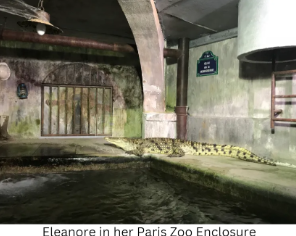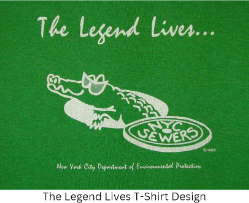Urban Legends—Sewer Alligators
- Eloise Wechsler
- Nov 4, 2024
- 6 min read
Every culture has folklore. Whether passed down through hundreds of storytellers for generations or originating from tabloid news less than 50 years ago, myths and superstitions are an integral part of every community. Now more than ever, these stories spread like wildfire through small towns and the internet alike. One kind of mythology that is very popular on the internet is the urban legend. Often, posters and spreaders of urban legends claim wild, unsubstantiated stories as fact, fabricating details for the sake of making the narrative more interesting. One such urban legend is the tale of the sewer alligators.
The tale of the sewer alligators originated in the United States in the mid 20th century. According to legend, families vacationing in Florida would bring back baby alligators to their home cities to keep as pets. When the alligators got too big to handle, they would flush them down the toilet to get rid of them. These alligators would supposedly keep growing in the sewer system, eating rats and trash and growing to enormous sizes. In some versions of the story, these alligators would become albino, with white skin and a sensitivity to sunlight as a result of their exile to the deep, dark sewers.
So, how much of this legend is true? Well, unlike many urban legends, there is some truth to this tale. Alligators were often sold as part of the exotic pet trade in Florida in the 1900s. Lax pet regulations allowed baby alligators to be sold as souvenirs to tourists, who would raise them in their home cities. Even today, wildlife services receive calls asking to surrender alligators bought as exotic pets.
And it’s far from uncommon for escaped pets to exist and thrive in places where they don’t belong. You’ve probably seen the vibrant green parrots that seem as common as pigeons in parks and cities around Portugal. These birds, called the rose-ringed parakeet or periquito-de-colar, originally escaped from the pet trade in the 1970s. Prior to that, their native home was Africa and India. Their preferred food source, which includes grain and fruit, is plentiful in Portugal, and the population has boomed over the past 50 years. A similar phenomenon occurred in Florida, where Burmese pythons released from the exotic pet trade have become a massive issue in Florida. Because the conditions are perfect for them to breed and thrive, they pose a significant threat to the biodiversity of Florida. Baby caimans, a species similar to alligators, are invasive and thrive in Florida as well as a result of the exotic pet industry. Therefore, it’s not unheard of for crocodilian species to survive and thrive in an environment that they’re not designed for, such as the sewer system.
But are there actually monstrous alligators flushed away by their owners lurking in the sewers underneath big cities in the United States, ready to feast upon unsuspecting sewer workers? Well… not exactly. There are, indeed, reports of alligators being found in sewers. According to the New York Department of Environmental Protection, small alligators might be swept into storm drains during rainy seasons. In 1932, a 1 meter long alligator was found in the Bronx, in New York. In 1935, the New York Times reported that a 2 meter long alligator had been found in a sewer in Harlem. These claims don’t necessarily prove the legend true, though. The New York alligator was already dead when it was found, and the Harlem alligator is thought to have fallen off of a steamer ship that had come from the Everglades, not raised in the sewers. Many more claims have arisen throughout the years of sewer alligators, but most were hearsay or unsubstantiated.

However, in 1984 a 2.5 meter Nile crocodile was found in Paris sewers. She was captured and brought to the Paris Zoo, where she still lives today in an enclosure designed to look like a sewer (see image of Eleanore, the alligator, in her enclosure). This may be the closest modern example we have to a monster crocodilian living in the sewers.
Furthermore, the idea of an alligator living in the sewers for more than a few weeks, much less years and years (wild alligators can live up to 50 years) is almost impossible. Alligators are evolved for tropical climates. Though an alligator could possibly survive the winters of New York, they need UV light (usually sunlight) to survive, which is impossible to come by in the sewers. Additionally, alligators and humans alike are susceptible to the diseases found in sewers such as salmonella and E. Coli. The few alligators that have been found in sewers were often starving and sickly, not thriving and growing to incredible lengths as the legend suggests.
As for their supposed developed albinism, this too is untrue. Though alligators can get albinism– Claude the albino alligator is one of the major attractions of the Steinhart Aquarium– this is a condition present from birth due to a lack of melanin, not developed later in life. Alligators with albinism would also probably be blind, as melanin is important for eye development– any albino alligators would have trouble hunting down sewer workers as the myth suggests.
Alligators aren’t the only animals alleged to thrive in sewers. In Hampstead, London, the sewers were supposedly once infested with enormous boars with an appetite for people. This story began in the 1800s amongst “toshers”, or people who entered the sewers to search for jewelry dropped into storm drains. These boars are rumored to have come from a pregnant sow who gave birth to a litter of pigs and raised them in the sewer, where, as seems typical for these stories, they grew to epic sizes while feasting on garbage. This story is likely a myth made up by the toshers of the city and spread by the journalist Henry Mayhew. Mayhew was a 19th century journalist who vividly described the inhumane life that impoverished people in London faced in his book series London and the London Poor. He included descriptions of the mythos and superstitions these people held. Included in this was a mention of the superstition of the monster sewer pigs. This helped to spread the idea far and wide and cement it into London's urban legends forever.

Regardless of how true or untrue this story is, it’s undeniable that the idea of sewer alligators has cemented itself in history as a timeless urban legend. February 9th is Alligators in the Sewer day in Manhattan. In the 1980 horror comedy Alligator, a baby alligator becomes a monster after eating lab rats in a sewer. Comic books and shows have included mentions of the urban legend, such as the DC supervillain Killer Croc or Leatherhead from Teenage Mutant Ninja Turtles. The New York City Environmental Protection even approved a shirt reading The Legend Lives with a sewer alligator on it. Though verified tales of gigantic alligators prowling the sewers are few and far between, this urban legend serves as a cautionary tale of the dangers of exotic pets and invasive species.
Bibliography
Kilgannon, Corey. “The Truth about Alligators in the Sewers of New York.” Nytimes.com, The New York Times, 26 Feb. 2020, www.nytimes.com/2020/02/26/nyregion/alligators-sewers-new-york.html. Accessed 11 Oct. 2024.
“Have You Seen a Parakeet?” Theportugalnews.com, Nov. 2021, www.theportugalnews.com/news/2021-11-01/have-you-seen-a-parakeet/63295. Accessed 11 Oct. 2024.
Lockwood, Julie L, et al. “When Pets Become Pests: The Role of the Exotic Pet Trade in Producing Invasive Vertebrate Animals.” Frontiers in Ecology and the Environment, vol. 17, no. 6, 3 June 2019, pp. 323–330, esajournals.onlinelibrary.wiley.com/doi/10.1002/fee.2059#, https://doi.org/10.1002/fee.2059. Accessed 11 Oct. 2024.
“Could Alligators Survive in the Sewers of New York City?” Ripleys.com, Ripley’s, 8 Feb. 2024, www.ripleys.com/stories/alligators-cant-live-in-the-sewers. Accessed 11 Oct. 2024.
Anderson, Lessley. “Behind the Alligator Pet Trade.” Fast Company, 24 Oct. 2014, www.fastcompany.com/3037273/behind-the-alligator-pet-trade. Accessed 12 Oct. 2024.
“The Many Meanings of the American Alligator.” Field School, 2014, www.getintothefield.com/blog/the-many-meanings-of-the-american-alligator. Accessed 12 Oct. 2024.
Gee, Oliver. “Meet Eleonore, the Crocodile Found in the Paris Sewers in 1984 - the Earful Tower.” The Earful Tower, 9 Sept. 2018, theearfultower.com/2018/09/09/meet-eleonore-the-crocodile-found-in-the-paris-sewers-in-1984/. Accessed 12 Oct. 2024.
News, Deseret, and Jan Harold Brunvand. “IF YOU CAN’T BEAT A GATOR, MAKE A T-SHIRT.” Deseret News, 30 June 1989, www.deseret.com/1989/6/30/18813649/if-you-can-t-beat-a-gator-make-a-t-shirt/. Accessed 12 Oct. 2024.
“The Swamp.” California Academy of Sciences, 2020, www.calacademy.org/exhibits/the-swamp. Accessed 14 Oct. 2024.
“What Makes an Animal Albino?” Iowa Department of Natural Resources, 2024, www.iowadnr.gov/About-DNR/DNR-News-Releases/ArticleID/2711/What-makes-an-animal-albino Accessed 14 Oct. 2024.
Hester, Jessica Leigh. “Londoners Once Wondered If Feral Hogs Roamed Victorian-Era Sewers.” Atlas Obscura, 3 Oct. 2019, www.atlasobscura.com/articles/london-sewer-pigs. Accessed 14 Oct. 2024.
“Removing Invasive Caimans from Florida Everglades, UF/IFAS Study Reveals Successful Strate.” Jacksonville District, 7 Aug. 2023, www.saj.usace.army.mil/Media/News-Releases/Article/3485927/removing-invasive-caimans-from-florida-everglades-ufifas-study-reveals-successf/. Accessed 14 Oct. 2024.
Dash, Mike. “Quite Likely the Worst Job Ever.” Smithsonian Magazine, 29 June 2012, www.smithsonianmag.com/history/quite-likely-the-worst-job-ever-319843/. Accessed 14 Oct. 2024.






Kommentit